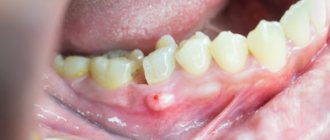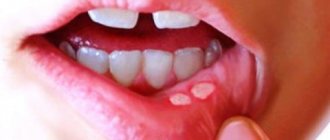What is stomatitis
Stomatitis (mucositis) is a disease that is accompanied by damage to soft tissues in the oral cavity.
It can be either an independent disease or a complication of various pathological processes, for example, measles, influenza, scarlet fever, etc. Until recently, stomatitis was considered a childhood disease. Today it is becoming more common in adults too. This trend raises questions about whether stomatitis is transmitted and, if so, how to protect yourself and your child. It all depends on the form of manifestation of the disease
Causes
Viral stomatitis in childhood develops due to various infections, since the baby has an underdeveloped immune system. He does not have time to recover from his previous illness. It also easily becomes infected from a patient with stomatitis. The situation is worsened by a lack of nutrients and vitamins in the body.
The disease in children is caused by the following pathogens:
- flu;
- HIV;
- mononucleosis;
- measles;
- papillomavirus;
- ARVI;
- enterovirus;
- chicken pox;
- herpes.
Most often, herpes is the causative agent of this disease; it accounts for up to 80% of all cases. Most of these viruses are persistent intracellular parasites. Therefore, this disease often becomes chronic. With this form, there is an alternation of exacerbations and remissions. The acute form can result in the formation of a carrier state, in which the pathogen remains in the cells, but there are no symptoms of the disease.
Most often, the infection affects children under four years of age. But it affects older children and teenagers.
The reasons why this happens are:
- undeveloped immune system;
- insufficient oral hygiene;
- weakness of local immunity;
- injuries to the gums and oral mucosa;
- general weakening of the body after an illness;
- long-term use of certain drugs (glucocorticoids, antibiotics, cytostatics).
Parallel inflammatory processes in other organs and systems also contribute to maintaining the infectious process in the mouth of children.
Symptoms of stomatitis
Stomatitis can be recognized by the following signs:
- ulcers, wounds, erosions and rashes on tissues;
- red color of the mucous membrane;
- plaque on the tongue, inner surface of the cheeks, palate;
- unpleasant taste;
- swelling of tissues;
- heavy salivation;
- bad breath;
- itching and burning – in some cases;
- discomfort and pain;
- bleeding gums – occasionally;
- increased body temperature;
- lymphadenitis.
Symptoms in children are always more pronounced. The child often feels severe pain. Adults tolerate the disease easily. Its symptoms usually do not cause severe discomfort.
When the first symptoms appear, you should immediately consult a doctor to protect yourself and, possibly, others.
Popular questions
The following are popular questions about stomatitis that people often ask specialists:
- When kissing, there is a risk of contracting some forms of stomatitis.
Is stomatitis contagious from kissing? There is a risk of infection with a fungal, viral or bacterial form through saliva; especially if there are wounds in the mouth.
- Is it transmitted by airborne droplets? The viral, less often bacterial, form of the disease is transmitted by airborne droplets.
- Is it possible to get infected from a child? A healthy adult can rarely become infected with stomatitis from a child; the risk increases if you have diabetes in an adult or tonsillitis in a child.
- How many days is stomatitis contagious? In most cases - 8 days.
- Is this an infectious disease? Stomatitis has a complex classification, which also includes infectious forms.
- Is it possible to die from stomatitis? Stomatitis is not a fatal disease, but the lack of treatment can lead to intoxication of the body, damage to internal organs, the transition of some pathologies to a chronic form and other complications.
When the first symptoms of stomatitis appear, it is recommended to consult a specialist for diagnosis and confirmation of the diagnosis. Timely adoption of measures contributes to rapid recovery without complications; during therapy, it is necessary to remember safety measures so as not to infect other people.
Types of disease
Stomatitis has different forms, depending on which the doctor determines whether it is contagious or not, and also prescribes appropriate treatment.
Allergic stomatitis
This is a common form of the disease that is difficult to treat. From the name it is clear that the cause of its development is an allergy, but it is necessary to find out what exactly it is. These could be medications, food, materials used for prosthetics. The disease is accompanied by the appearance of ulcers, which provoke pain.
Viral stomatitis
The most common type of viral stomatitis is herpetic stomatitis, the causative agent of which is the herpes virus. There are other forms that are provoked by adenovirus, enterovirus, etc. They are often found in children under 5–6 years of age, but are also common among older age groups. A feature of viral stomatitis is its erosive spread, when one ulcer appears next to another. Herpes mucositis may cause complications such as fever, nausea, vomiting and diarrhea.
This form of the disease is transmitted to others by contact and airborne droplets. If it is diagnosed, for example, in someone in kindergarten, then quarantine must be introduced. Infection occurs through dishes and toys, so the disease can quickly spread from child to child.
The virus spreads from nursing mothers to children if hygiene rules are violated. Adults become infected even through handshakes. Sneezing also causes the disease to develop.
Aphthous stomatitis
This form is common among adults. It develops against the background of a weakening of the body’s immune forces, so aphthous stomatitis is a common occurrence in spring and autumn. With this type of disease, characteristic aphthae appear - small ulcers. They can be single or group. Aphthous mucositis is not spread from person to person.
Fungal stomatitis
The disease manifests itself in children and adults, mainly in infants and women. It is provoked by fungi of the genus Candida, which are activated in the oral cavity when the immune system is weakened. The cause of fungal stomatitis can be long-term use of antibiotics. In addition to ulcers, its characteristic feature is a cheesy coating on the tongue, palate and inner surface of the cheeks.
Bacterial stomatitis
This type of disease is diagnosed when the oral cavity is affected by microorganisms, most often streptococci, staphylococci. The manifestation of bacterial stomatitis is provoked by tuberculosis, as well as sexually transmitted diseases, for example, gonorrhea, syphilis. More often, children whose immunity is not strong enough suffer from it. But everyone must be careful. The disease is transmitted from children to adults through dishes, toys, and damage to the mucous membrane.
This form is characterized by swelling in the oral cavity, redness of the mucous membrane and hardening of the palate, as well as an unpleasant odor, ulceration and cracks. Symptoms of intoxication may appear: vomiting, weakness, rapid pulse.
Other forms of stomatitis
In addition to the above types of disease, the following can also be distinguished:
- chemical stomatitis - occurs as a result of burns to the oral cavity with alkaline substances or acid;
- traumatic - ulcers are formed as a result of impact and disruption of tissue integrity;
- radiation – develops as a result of radiation.
Such forms are non-contagious and therefore do not pose a danger to other people.
Features of the spread of stomatitis in children and adults
Children under the age of 3-4 years are at risk because they have a poorly developed immune system and the body cannot independently resist the activity of pathogens. Infection most often occurs through direct contact, toys and airborne droplets.
Reference! It is more difficult for a healthy adult to become infected from a child; this usually occurs due to malfunctions of the immune system, diabetes mellitus and infection with viruses, which can additionally provoke the appearance of stomatitis.
The occurrence of the traumatic form of the disease does not depend on age.
Ways of transmission of stomatitis
Let's summarize. Viral, bacterial and herpetic forms of stomatitis are contagious. Knowing how the disease is transmitted, you can protect yourself and your loved ones. Ways of transmission of infection:
- airborne - sneezing, coughing;
- household items - common dishes, linen, personal items;
- toys, raw pacifiers, rattles;
- dirty hands;
- unwashed food;
- biological fluids - through saliva, blood, breast milk;
- Pets can carry the virus.
It is possible to catch the infection anywhere – from the street to your own home. You can get infected from both a child and an adult.
Treatment
Treatment of viral stomatitis in children is carried out under the mandatory supervision of a doctor. Mild forms can be treated at home; in severe cases, the baby is admitted to a hospital. Children are prescribed bed rest and a diet. Food should be pureed, warm, and not irritate the affected mucous membrane. The patient is advised to drink more fluids.
The disease requires complex therapy. For this disease, local and general treatment methods are used.
The following medications are indicated for the child:
- antiviral drugs (Panavir, Acyclovir) - taken strictly according to the regimen prescribed by the doctor; if you do not follow his instructions, a relapse of the disease is possible;
- antihistamines (Suprastin, Citrine, Loratadine) - reduce swelling and reduce pain;
- immunomodulators (Imunofan, Timalin) – strengthen the baby’s immune system;
- antipyretics (Panadol, Nurofen) are used at high temperatures.
Local remedies are used to treat infectious stomatitis. They relieve inflammation and swelling.
For this purpose the following are used:
- antiseptic solutions (Panavir, Miramistin) - the oral cavity is rinsed every hour with a soda solution or Furacilin, and then treated with antiseptics;
- dental gels (Kamistad, Dentinox), which have an anti-inflammatory, analgesic, disinfecting effect, are used thirty minutes before meals;
- antiviral ointments (Acyclovir, Oxolinic) - penetrate the virus and destroy it, the oral cavity is lubricated up to five times a day for two weeks.
Mouth rinses with herbal infusions are used. Herbs are used to relieve irritation and pain (chamomile, calendula, sage).
Physiotherapeutic methods are used: tube quartz, devices with infrared irradiation.
How to treat
Most often, the treatment procedure is limited to local exposure to the affected areas of the mucous membrane and soft tissue. Severe and painful lesions are treated with painkillers and antiseptic drugs, and applications with wound healing and anti-inflammatory agents are prescribed.
Viruses cannot be treated with antibiotics! Do not self-medicate or take potent drugs under any circumstances, they can only worsen the situation. To speed up recovery, your doctor may prescribe you medications containing human interferon (Viferon, Anaferon, etc.).
Also, for viral stomatitis, treatment can be aimed at eliminating local rashes using antiviral ointments (oxolinic, Zovirax, acyclovir and others). To increase the overall level of immunity, you will most likely be prescribed echinacea-based drugs, vitamins and immunomodulators.
At home, to speed up the healing of ulcers and sores, you can use herbal decoctions (sage, calendula, chamomile), oak bark for rinsing, and Tantum Verde spray for pain relief. Applications with retinol acetate and sea buckthorn oil are also very useful.
Among other things, diet is very important, without which treatment may not give the expected results. All foods consumed should be neutral in taste (no salt, acid, sugar or spices), in puree or porridge form, and lukewarm (hot and cold drinks and food are excluded). Under no circumstances should you refuse to eat because of pain.
Prevention
It is not possible to completely prevent the development of this infection in a child. Most people are already infected with viruses at birth, but it is quite possible to reduce the incidence of the disease.
To do this, the following measures are used:
- if one of the adults is infected, they should not be allowed to contact the child;
- choose a group in kindergarten with a small number of children;
- If possible, do not attend mass events during epidemics;
- it is necessary to harden the child (walk barefoot at home, go to the pool);
- stop bad habits (sucking fingers, toys, other objects);
- thoroughly wash and treat the child’s toys and dishes;
- treatment of all surfaces in the apartment using antiseptics.
Infectious stomatitis in children is a rather unpleasant disease. If you follow all the doctor’s recommendations and preventive measures, you can minimize the occurrence of this disease in your baby.











